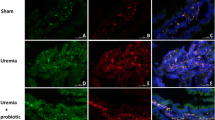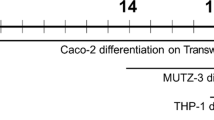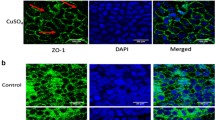Abstract
The aim of this study was to investigate the effect and possible underlying mechanism of La2(CO3)3 deposition on GI mucosal inflammation. Our results showed that La2(CO3)3 can dissolve in artificial gastric fluids and form lanthanum phosphate (LaPO4) precipitates with an average size of about 1 μm. To mimic the intestinal mucosa and epithelial barrier, we established a Caco-2/THP-1 macrophage coculture model and a Caco-2 monoculture model, respectively. Our findings demonstrated that the medium of THP-1 macrophages stimulated by LaPO4 particles can damage the Caco-2 monolayer integrity in the coculture model, while the particles themselves had no direct impact on the Caco-2 monolayer integrity in the monoculture model. We measured values of trans-epithelial electrical resistance and detected images using a laser scanning confocal microscope. These results indicate that continuous stimulation of LaPO4 particles on macrophages can lead to a disruption of intestinal epithelium integrity. In addition, LaPO4 particles could stimulate THP-1 macrophages to secrete both IL-1β and IL-8. Although LaPO4 particles can also promote Caco-2 cells to secrete IL-8, the secretion was much lower than that produced by THP-1 macrophages. In summary, the deposition of La2(CO3)3 has been shown to activate macrophages and induce damage to intestinal epithelial cells, which may exacerbate inflammation in patients with chronic kidney disease. Therefore, patients taking lanthanum carbonate, especially those with gastrointestinal mucosal inflammation, should be mindful of the potential for drug deposition in the GI system.
Graphical abstract

A schematic diagram of the effect and possible underlying mechanism of the deposition of La2(CO3)3 on GI mucosal inflammation.







Similar content being viewed by others
Data availability
The data underlying this article are available in the article and supplementary materials.
References
Lloret MJ, Ruiz-García C, Dasilva I, Furlano M, Barreiro Y, Ballarín J, Bover J (2013) Lanthanum carbonate for the control of hyperphosphatemia in chronic renal failure patients: a new oral powder formulation-safety, efficacy, and patient adherence. Patient Prefer Adher 7:1147–1156
Ogata H, Takeshima A, Ito H (2022) An update on phosphate binders for the treatment of hyperphosphatemia in chronic kidney disease patients on dialysis: a review of safety profiles. Expert Opin Drug Saf 21:947–955
Haratake J, Yasunaga C, Ootani A, Shimajiri S, Matsuyama A, Hisaoka M (2015) Peculiar histiocytic lesions with massive lanthanum deposition in dialysis patients treated with lanthanum carbonate. Am J Surg Pathol 39:767–771
Hoda RS, Sanyal S, Abraham JL, Everett JM, Hundemer GL, Yee E, Lauwers GY, Tolkoff-Rubin N, Misdraji J (2017) Lanthanum deposition from oral lanthanum carbonate in the upper gastrointestinal tract. Histopathology 70:1072–1078
Makino M, Kawaguchi K, Shimojo H, Nakamura H, Nagasawa M, Kodama R (2015) Extensive lanthanum deposition in the gastric mucosa: the first histopathological report. Pathol Inter 65:33–37
Iwamuro M, Urata H, Tanaka T, Okada H (2020) Review of the diagnosis of gastrointestinal lanthanum deposition. World J Gastroenterol 26:1439–1449
Nishida S, Ota K, Hattori K, Iwatsubo T, Kawaguchi S, Kojima Y, Takeuchi T, Maeda T, Sakaguchi M, Higuchi K (2020) Investigation of the clinical significance and pathological features of lanthanum deposition in the gastric mucosa. BMC Gastroenterol 20:396
Ullmann JM, Erbersdobler A (2021) Gastric lanthanosis (lanthanum deposition) in an immuno-suppressed patient that discontinued lanthanum carbonate seven years ago. Clin Case Rep 9:e05075
Schafer H, Struck B, Feldmann EM, Bergmann F, Grage-Griebenow E, Geismann C, Ehlers S, Altevogt P, Sebens S (2013) TGF-β1-dependent L1CAM expression has an essential role in macrophage-induced apoptosis resistance and cell migration of human intestinal epithelial cells. Oncogene 32:180–189
Smith PD, Smythies LE, Shen R, Greenwell-Wild T, Gliozzi M, Wahl SM (2011) Intestinal macrophages and response to microbial encroachment. Mucosal Immunol 4:31–42
Sansonetti PJ (2004) War and peace at mucosal surfaces. Nat Rev Immunol 4:953–964
Pardo-Camacho C, Gonzalez-Castro AM, Rodino-Janeiro BK, Pigrau M, Vicario M (2018) Epithelial immunity: priming defensive responses in the intestinal mucosa. Am J Physiol Gastrointest Liver Physiol 314:G247–G255
Zmora N, Levy M, Pevsner-Fischer M, Elinav E (2017) Inflammasomes and intestinal inflammation. Mucosal Immunol 10:865–883
Peterson LW, Artis D (2014) Intestinal epithelial cells: regulators of barrier function and immune homeostasis. Nat Rev Immunol 14:141–153
Mowat AM (2011) Mucosal macrophages in intestinal homeostasis and inflammation. J Innate Immun 3:550–564
Mahida YR (2000) The key role of macrophages in the immunopathogenesis of inflammatory bowel disease. Inflamm Bowel Dis 6:21–33
Smythies LE, Sellers M, Clements RH, Mosteller-Barnum M, Meng G, Benjamin WH, Orenstein JM, Smith PD (2005) Human intestinal macrophages display profound inflammatory anergy despite avid phagocytic and bacteriocidal activity. J Clin Invest 115:66–75
Schenk M, Mueller C (2008) The mucosal immune system at the gastrointestinal barrier. Best Pract Res Cl Ga 22:391–409
Srikanth CVMB (2010) Interactions of the intestinal epithelium with the pathogen and the indigenous microbiota: a three-way crosstalk. Interdiscip Perspect Infect Dis 2008:626827
Gabay C, Lamacchia C, Palmer G (2010) IL-1 pathways in inflammation and human diseases. Nat Rev Rheumatol 6:232–241
Al-Sadi RM, Ma TY (2007) IL-1β causes an increase in intestinal epithelial tight junction permeability. J Immunol 178:4641–4649
Al-Sadi R, Guo SH, Dokladny K, Smith MA, Ye DM, Kaza A, Watterson DM, Ma TY (2012) Mechanism of interleukin-1β induced-increase in mouse intestinal permeability in vivo. J Interf Cytok Res 32:474–484
Cotton JAPJ, Muruve DA, Jijon HB, Buret AG, Beck PL (2016) Interleukin-8 in gastrointestinal inflammation and malignancy: induction and clinical consequences. Int J Interferon Cytokine Mediat Res 8:13–34
Sartor RB (1994) Cytokines in intestinal inflammation-pathophysiological and clinical considerations. Gastroenterol 106:533–539
Li RB, Ji ZX, Qin HQ, Kang XD, Sun BB, Wang MY, Chang CH, Wang X, Zhang HY, Zou HF et al (2014) Interference in autophagosome fusion by rare earth nanoparticles disrupts autophagic flux and regulation of an Interleukin-1β producing inflammasome. ACS Nano 8:10280–10292
Artursson P, Palm K, Luthman K (2001) Caco-2 monolayers in experimental and theoretical predictions of drug transport. Adv Drug Deliver Rev 46:27–43
Pinto M, Robineleon S, Appay MD, Kedinger M, Triadou N, Dussaulx E, Lacroix B, Simonassmann P, Haffen K, Fogh J et al (1983) Enterocyte-like differentiation and polarization of the human-colon carcinoma cell-line Caco-2 in culture. Biol Cell 47:323–330
Kampfer AAM, Urban P, Gioria S, Kanase N, Stone V, Kinsner-Ovaskainen A (2017) Development of an in vitro co-culture model to mimic the human intestine in healthy and diseased state. Toxicol in Vitro 45:31–43
Wottrich R, Diabate S, Krug HF (2004) Biological effects of ultrafine model particles in human macrophages and epithelial cells in mono- and co-culture. Int J Hyg Envir Heal 207:353–361
Leonard F, Collnot EM, Lehr CM (2010) A three-dimensional coculture of enterocytes, monocytes and dendritic cells to model inflamed intestinal mucosa in vitro. Mol Pharmaceut 7:2103–2119
Liu ZM, Xiao Y, Chen W, Wang Y, Wang B, Wang GC, Xu XR, Tang RK (2014) Calcium phosphate nanoparticles primarily induce cell necrosis through lysosomal rupture: the origination of material cytotoxicity. J Mater Chem B 2:3480–3489
Kucharzik T, Hudson JT, Lugering A, Abbas JA, Bettini M, Lake JG, Evans ME, Ziegler TR, Merlin D, Madara JL et al (2005) Acute induction of human IL-8 production by intestinal epithelium triggers neutrophil infiltration without mucosal injury. Gut 54:1565–1572
Curran MP, Robinson DM (2009) Lanthanum carbonate: A review of its use in lowering serum phosphate in patients with end-stage renal disease. Drugs 69:2329–2349
Samy R, Faustino PJ, Adams W, Yu L, Khan MA, Yang YS (2010) Development and validation of an ion chromatography method for the determination of phosphate-binding of lanthanum carbonate. J Pharmaceut Biomed 51:1108–1112
Tsugita M, Morimoto N, Nakayama M (2017) SiO2 and TiO2 nanoparticles synergistically trigger macrophage inflammatory responses. Part Fibre Toxicol 14:11
Mottram PL, Leong D, Crimeen-Irwin B, Gloster S, Xiang SD, Meanger J, Ghildyal R, Vardaxis N, Plebanski M (2007) Type 1 and 2 immunity following vaccination is influenced by nanoparticle size: Formulation of a model vaccine for respiratory syncytial virus. Mol Pharmaceut 4:73–84
Yue H, Wei W, Yue ZG, Lv PP, Wang LY, Ma GH, Su ZG (2010) Particle size affects the cellular response in macrophages. Eur J Pharm Sci 41:650–657
Huang HX, Liu HX, Yang XG (2023) Lanthanum carbonate, a potent and selective phosphate binder, is transported and absorbed mainly via M cells in gastrointestinal tract. Metallomics 15:mfad036
Mabbott NA, Donaldson DS, Ohno H, Williams IR, Mahajan A (2013) Microfold (M) cells: important immunosurveillance posts in the intestinal epithelium. Mucosal Immunol 6:666–677
Corr SC, Gahan CCGM, Hill C (2008) M-cells: origin, morphology and role in mucosal immunity and microbial pathogenesis. Fems Immunol Med Mic 52:2–12
Rothenberg MEAH, Longacre TA, Pasricha PJ (2015) Lanthanum-induced gastrointestinal histiocytosis. ACG Case Rep J 2:187–189
Baggiolini M, Walz A, Kunkel SL (1989) Neutrophil-activating peptide-1 interleukin-8, a novel cytokine that activates neutrophils. J Clin Invest 84:1045–1049
He Y, Liu S, Leone S, Newburg DS (2014) Human colostrum oligosaccharides modulate major immunologic pathways of immature human intestine. Mucosal Immunol 7:1326–1339
Huang FC (2021) The interleukins orchestrate mucosal immune responses to salmonella infection in the intestine. Cells 10:3492
Perry CM, Plosker GL (2014) Sevelamer carbonate: a review in hyperphosphataemia in adults with chronic kidney disease. Drugs 74:771–792
Liang YX, Suarez Y (2016) The association of sevelamer crystals with severe gastrointestinal tract damage and perforation. Am J Clin Pathol 146:S104–S142
Nambiar SPU, Devasahayam J, Oliver T, Karippot A (2018) Colonic mucosal ulceration and gastrointestinal bleeding associated with sevelamer crystal deposition in a patient with end stage renal disease. Case Rep Nephrol 2018:4708068
Tonelli M, Pannu N, Manns B (2010) Oral phosphate binders in patients with kidney failure. New Engl J Med 362:1312–1324
Acknowledgements
This work was supported by the National Natural Science Foundation of China (Grant No. 21277006 and 21671009).
Author information
Authors and Affiliations
Contributions
HXL and XGY designed the study. YJS and HXL performed the experiments. All authors analyzed the data. HXL and XGY co-wrote the manuscript. All authors reviewed and concurred with the final manuscript.
Corresponding authors
Ethics declarations
Conflict of interest
The authors declare that they have no competing interest.
Additional information
Publisher's Note
Springer Nature remains neutral with regard to jurisdictional claims in published maps and institutional affiliations.
Supplementary Information
Below is the link to the electronic supplementary material.
Rights and permissions
Springer Nature or its licensor (e.g. a society or other partner) holds exclusive rights to this article under a publishing agreement with the author(s) or other rightsholder(s); author self-archiving of the accepted manuscript version of this article is solely governed by the terms of such publishing agreement and applicable law.
About this article
Cite this article
Song, YJ., Liu, HX. & Yang, XG. The deposition of lanthanum carbonate may activate macrophages to induce gastrointestinal mucosal injury in patients with chronic kidney disease: an in vitro caco-2/THP-1 macrophage coculture model study. J Biol Inorg Chem 29, 101–112 (2024). https://doi.org/10.1007/s00775-023-02033-x
Received:
Accepted:
Published:
Issue Date:
DOI: https://doi.org/10.1007/s00775-023-02033-x




